Recycled board makes archive boxes as strong as elephant hide
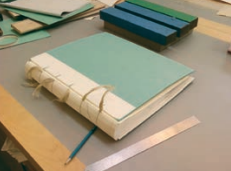 CONSERVATION BY DESIGN – CXD are manufacturers of archival storage boxes, folders and envelopes from its exclusive range of acid-free papers and boards. In addition to a number of stock sizes, the company has a huge collection of box, folder and envelope cutting dies designed to meet customers’ specific requirements and to which they are continuously adding.
CONSERVATION BY DESIGN – CXD are manufacturers of archival storage boxes, folders and envelopes from its exclusive range of acid-free papers and boards. In addition to a number of stock sizes, the company has a huge collection of box, folder and envelope cutting dies designed to meet customers’ specific requirements and to which they are continuously adding.
The Premier Duo Archival Boxboard and Premier Archival Paper developed by the founder of CXD, Stuart Welch, has become the benchmark for quality when making acid-free paper-based products.
Stuart explained: “We can normally meet a customer's needs using our existing dies, which saves the cost of a new die. Setting up a die cutting platen takes time and we require an order quantity of 100 boxes or more. However, in 1992 CXD were the first company outside the USA to offer custom-made one-off items made on a computer-generated cutting machine. When we launched our Smart Box manufacturing service in 1992 we revolutionised the way that custom-made rare book and document enclosures are created”.
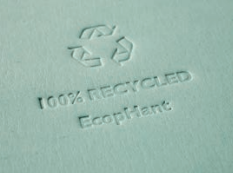
In CXD’s factory the process of die cutting generates waste trim around the edge of the paper or board from which the folder or box is cut. However, Stuart says that he is ‘proud of his waste’.
Stuart thought that the waste deserved to be recycled into something special which would also be of benefit to CXD customers. First, he hit upon the idea of making an Archival Millboard which he named ‘Superior Millboard’ for use by bookbinders and conservators of rare books.
“For more than 22 years we have been recycling our CXD Premier grade acid-free paper and board waste,” Stuart explained. “Re-pulping our waste gives it another life when it becomes our Green EcopHant Boxboard and Superior Millboard. We estimate that, not only have we created a fantastic ‘A’ Grade recycled fully archival quality millboard and boxboard, but have saved more than 600 tonnes of high-quality archival paper and board fibre from going to waste or being mixed with general paper waste and turned into a lower grade product.
“By managing our waste, CXD make it possible to offer a quality of board that we would be confident to guarantee for 500 years if that made sense.
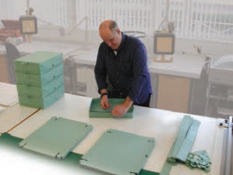
However, you only need to look at paper and boards made 500 years ago from high-quality fibre to see that it does, indeed, make sense.”
Millboard is made on a special papermaking machine known as an intermittent cylinder mould machine. The machine is a large drum which turns and picks up a layer of fibre from the pulp on every rotation until it has reached the required thickness.
At that point it is cut from the drum and goes on for processing, which includes being pressed to a highdensity board suitable for bookbinding.
That kind of machine normally makes low-quality products and it was remarkably hard for CXD to find a mill which could achieve the quality required. They tried three companies before finding one who was willing to work with CXD to develop a board of the standard required.
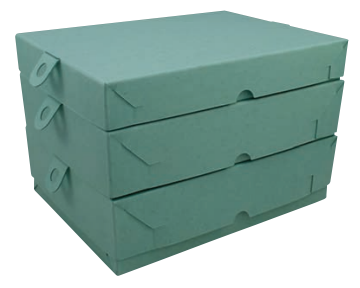
It soon became obvious that the demand for Superior Millboard would not be enough to satisfy the amount of the CXD Premier waste being generated. At that time most archives in the UK were using a non-archival specification boxboard which had a recycled low-density pulp centre lined on each side with a stronger Kraft (meaning strength in German) paper.
Some boxes are made with a board which has a polyethylene layer on the inside to act as a barrier against acid and other pollutants coming from the low-grade recycled centre of the board.
CXD decided to make a fully archival acid-free boxboard from its Premier Duo post-production waste. That board needed to be of a little lower density than the Millboard, otherwise it would be too hard to die cut and fold into boxes. Stuart named it EcopHant Archival Boxboard: partly because it was as tough as elephant hide and was eco friendly. He decided to make the Superior Millboard green, using a bleed-proof dye to distinguish it from the non-archival millboard available on the market. He called the colour Elephant Green.
There was some resistance to start with from customers who were so used to their brown archive boxes and found it hard to make the change to the higher quality and more durable box. The EcopHant boxboard is enormously strong and offers great value for money. The standard EcopHant boxes are assembled using brass wire stitches or rivets.
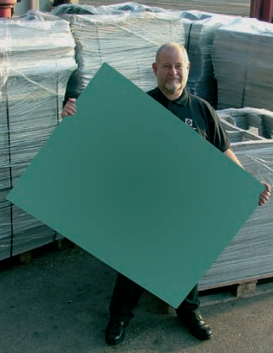 CXD founder Stuart Welch with a sheet of Superior MillboardStuart continued the story: “In response to an enquiry from Essex Record Office we designed a new range of boxes, which we named after their first conservator Amy Lydamore. Those boxes are designed to be flat packed for self-assembly, which saves on transport and storage space for the customer when compared to stitched or riveted boxes. If requested CXD will assemble the boxes and deliver assembled. We are very fond of the design of these boxes, for which we also created n innovative pull tab at no extra cost.
CXD founder Stuart Welch with a sheet of Superior MillboardStuart continued the story: “In response to an enquiry from Essex Record Office we designed a new range of boxes, which we named after their first conservator Amy Lydamore. Those boxes are designed to be flat packed for self-assembly, which saves on transport and storage space for the customer when compared to stitched or riveted boxes. If requested CXD will assemble the boxes and deliver assembled. We are very fond of the design of these boxes, for which we also created n innovative pull tab at no extra cost.
“The waste trim from our EcopHant boxes also goes into our recycling mix and it all goes round and round and round, ad infinitum.”
Under the direction of Stuart Welch, CXD have always been known as innovators. They have developed many of the products which are now relied upon by conservators in the UK, Europe and around the world.
Stuart concluded: “We pride ourselves on the quality of our products and are the proud holders of a Royal Warrant of Appointment to Her Majesty Queen Elizabeth II.”
• For further information visit the website at www.cxdinternational.com.













